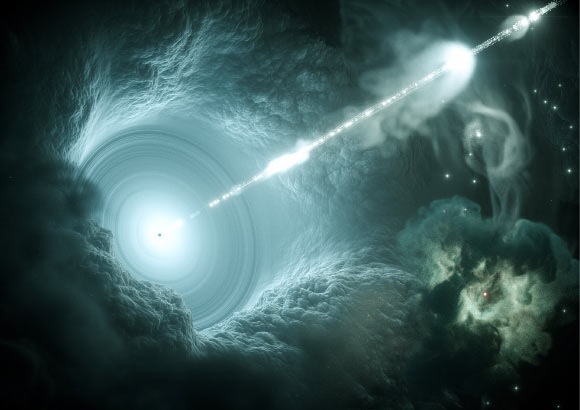TESS Detects Bright, Long-Lasting Gamma-Ray Burst
May 4, 2021 by News Staff / Source
Astronomers using NASA’s Transiting Exoplanet Survey Satellite (TESS) exoplanet-hunting mission have detected the rising and decaying optical afterglow of the gamma-ray burst event GRB 191016A.

An artist’s impression of a blazar. Image credit: DESY / Science Communication Lab.
GRB 191016A occurred on October 16, 2019, in a previously uncataloged galaxy in the northern constellation of Aries.
The gamma-ray burst was first detected by the Burst Alert Telescope (BAT) onboard NASA’s Neil Gehrels Swift Observatory.
The burst occurred too close to the Moon for Swift to safely slew to its position, preventing follow-up observations.
TESS clearly detected the rising pre-peak light curve of GRB 191016A.
“Our findings prove this TESS telescope is useful not just for finding new planets, but also for high-energy astrophysics,” said Dr. Krista Lynne Smith, an astrophysicist in the Department of Physics at Southern Methodist University and Stanford University.

TESS full-frame image in the cadence just before the BAT trigger (left) and at the peak flux of the GRB 191016A burst (center); the emergence of the afterglow is apparent in the center of the image, indicated by the white arrow; the right panel shows the same region of the sky, with a slightly different orientation, in the Digitized Sky Survey (DSS); a small inset of TESS image is provided in the bottom left corner to demonstrate the change in orientation. Image credit: Smith et al., doi: 10.3847/1538-4357/abe6a2.
Dr. Smith and colleagues calculated that GRB 191016A had a peak magnitude of 15.1, which means it was 10,000 times fainter than the faintest stars we can see with the naked eyes.
Most gamma ray bursts are dimmer — closer to 160,000 times fainter than the faintest stars.
It is estimated that light from the burst’s host galaxy had been traveling 11.7 billion years before becoming visible by TESS.
GRB 191016A reached its peak brightness sometime between 1,000 and 2,600 seconds, then faded gradually until it fell below the ability of TESS to detect it some 7,000 seconds after it first went off.
“Because the burst reached its peak brightness later and had a peak brightness that was higher than most bursts, it allowed the TESS telescope to make multiple observations before the burst faded below the telescope’s detection limit,” Dr. Smith said.
“We’ve provided the only space-based optical follow-up on this exceptional burst.”
The results were published in the Astrophysical Journal.
_____
Krista Lynne Smith et al. 2021. GRB 191016A: A Long Gamma-Ray Burst Detected by TESS. ApJ 911, 43; doi: 10.3847/1538-4357/abe6a2
http://www.sci-news.com/astronomy/tess-gamma-ray-burst-09621.html?utm_source=feedburner&utm_medium=email&utm_campaign=Feed%3A+BreakingScienceNews+%28Breaking+Science+News%29
Thanks to: http://www.sci-news.com
May 4, 2021 by News Staff / Source
Astronomers using NASA’s Transiting Exoplanet Survey Satellite (TESS) exoplanet-hunting mission have detected the rising and decaying optical afterglow of the gamma-ray burst event GRB 191016A.

An artist’s impression of a blazar. Image credit: DESY / Science Communication Lab.
GRB 191016A occurred on October 16, 2019, in a previously uncataloged galaxy in the northern constellation of Aries.
The gamma-ray burst was first detected by the Burst Alert Telescope (BAT) onboard NASA’s Neil Gehrels Swift Observatory.
The burst occurred too close to the Moon for Swift to safely slew to its position, preventing follow-up observations.
TESS clearly detected the rising pre-peak light curve of GRB 191016A.
“Our findings prove this TESS telescope is useful not just for finding new planets, but also for high-energy astrophysics,” said Dr. Krista Lynne Smith, an astrophysicist in the Department of Physics at Southern Methodist University and Stanford University.

TESS full-frame image in the cadence just before the BAT trigger (left) and at the peak flux of the GRB 191016A burst (center); the emergence of the afterglow is apparent in the center of the image, indicated by the white arrow; the right panel shows the same region of the sky, with a slightly different orientation, in the Digitized Sky Survey (DSS); a small inset of TESS image is provided in the bottom left corner to demonstrate the change in orientation. Image credit: Smith et al., doi: 10.3847/1538-4357/abe6a2.
Dr. Smith and colleagues calculated that GRB 191016A had a peak magnitude of 15.1, which means it was 10,000 times fainter than the faintest stars we can see with the naked eyes.
Most gamma ray bursts are dimmer — closer to 160,000 times fainter than the faintest stars.
It is estimated that light from the burst’s host galaxy had been traveling 11.7 billion years before becoming visible by TESS.
GRB 191016A reached its peak brightness sometime between 1,000 and 2,600 seconds, then faded gradually until it fell below the ability of TESS to detect it some 7,000 seconds after it first went off.
“Because the burst reached its peak brightness later and had a peak brightness that was higher than most bursts, it allowed the TESS telescope to make multiple observations before the burst faded below the telescope’s detection limit,” Dr. Smith said.
“We’ve provided the only space-based optical follow-up on this exceptional burst.”
The results were published in the Astrophysical Journal.
_____
Krista Lynne Smith et al. 2021. GRB 191016A: A Long Gamma-Ray Burst Detected by TESS. ApJ 911, 43; doi: 10.3847/1538-4357/abe6a2
http://www.sci-news.com/astronomy/tess-gamma-ray-burst-09621.html?utm_source=feedburner&utm_medium=email&utm_campaign=Feed%3A+BreakingScienceNews+%28Breaking+Science+News%29
Thanks to: http://www.sci-news.com






 Sat Mar 23, 2024 11:33 pm by globalturbo
Sat Mar 23, 2024 11:33 pm by globalturbo

